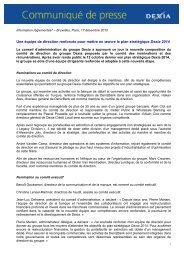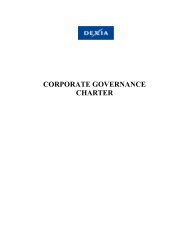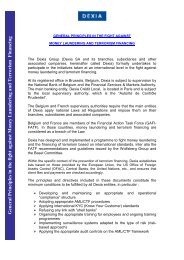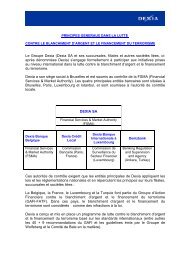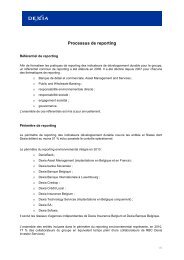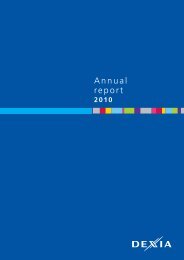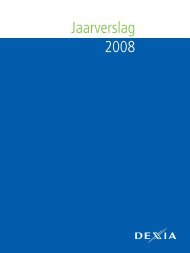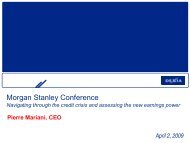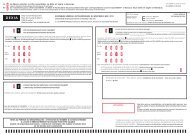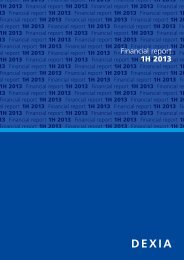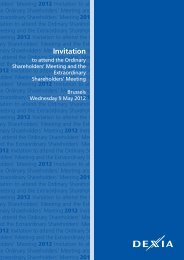Annual report 2009 - Dexia.com
Annual report 2009 - Dexia.com
Annual report 2009 - Dexia.com
- No tags were found...
Create successful ePaper yourself
Turn your PDF publications into a flip-book with our unique Google optimized e-Paper software.
Human resourcesAGE PYRAMID> 5955-5950-5445-4940-4435-3930-3425-2920-24< 2020%FemaleMale15% 10% 5% 0% 5% 10% 15% 20%SENIORITY PYRAMIDFemaleMale> 4036-4031-3526-3021-2516-2011-156-100-550% 40% 30% 20% 10 % 0% 10% 20% 30% 40% 50%• Men/women – The overall division of workforce betweenmen and women is well balanced, at 51% and 49%respectively.• Turnover – 94.8% of workforce on indefinite-termcontracts.• Part-time – 15% of Group members of staff work parttime.• Training days – The average number of training days permember of staff (Full Time Equivalent) is 1.7 days per yearfor the Group as a whole and rises to 3.5 days for job poolsin France, Belgium and Luxembourg.Recruitment, talent management andmobilityConsidering the manner in which the economic situation hasdeveloped and its impact on the banking world, <strong>2009</strong> wasmarked by a continuity of the human resources managementpolicy which began at the end of 2008.<strong>Dexia</strong> therefore very severely limited external recruitmentin favour of a policy of mobility within the Group. In thatregard, mobility centres were created in order to enablemembers of staff whose posts were lost to find another postwithin the Group.Indeed, for the three main job pools and for all the internationalentities, a dedicated Human Resources team was putin place to manage mobility and professional reclassificationbetween the entities: the <strong>Dexia</strong> Mobility Centre.By gathering all the posts vacant in the Group on oneaccessible support, and collecting the inter-entity reclassificationrequirements, it was able to seek reclassification solutionsthroughout the entire Group and place local HumanResources teams in contact with members of staff who werelosing their jobs in another entity. There was also a caseby-caseanalysis of training actions or the adaptation to beplanned to facilitate professional mobility.In addition to these efforts towards reclassification and internalmobility, solutions involving voluntary departures, retirementsand early retirements enabled forced redundancies tobe avoided in the Group’s main job pools (France, Belgium,Luxembourg).This period also saw a reinforcement of the identification andmanagement of “Key People” and “High Potentials” in theGroup. Increased efforts were made in terms of motivationand actions to retain teams, in particular through meetingswith top management, training and specific <strong>com</strong>municationactions.The optimisation of the Group’s career management and performancetools also enabled more in-depth work to be doneon reconciling the <strong>com</strong>pany’s needs and the skills of membersof staff, and on the conception of specific career pathsand take-over plans, the intention being to develop these lasttwo aspects during 2010.Working conditionsThe implementation of the transformation plan has majorconsequences with regard to the evolution of the workingconditions of members of staff. For a long time the Grouphas been eager to give its employees the greatest possiblevisibility over their <strong>com</strong>pany and their evolution within it, toprevent and to detect situations of stress, particularly withthe introduction of a policy to prevent “mental risks”.Within the entities, there are numerous mechanisms todetect, prevent and manage stress.Several information channels currently enable such risksto be detected in the entities (personnel representatives,work doctor, social assistants, internal and external advisoryteams, recovery tools as part of the quality certification process,satisfaction surveys and so on).As for prevention, in addition to existing measures (preventivemedical consultations, ergonomic advice, training ofmembers of staff and managers and so on), new measureshave been introduced, such as the extension of training andcoaching actions, and these will be emphasised in 2010.Furthermore, situations declared as stress-creating are takenin hand and various means of assistance are adopted: viathe Human Resources department, internal and/or externalexperts, coaching measures, psychological hotlines, interviewsand the improved scheduling of working time.<strong>Dexia</strong> Corporate University has also created new coursesaligned to the ac<strong>com</strong>paniment of change and stress managementfor all: members of staff, managers, HumanResources teams (cf. below).In 2010, these measures will be further strengthened andharmonised in order to systematise a series of mandatoryactions in each entity, and this will constitute a minimum<strong>com</strong>mon basis at both a preventive and a corrective level.Management <strong>report</strong>Consolidatedfinancial statements<strong>Annual</strong> financial statementsAdditional information<strong>Annual</strong> <strong>report</strong> <strong>2009</strong> <strong>Dexia</strong> 51



